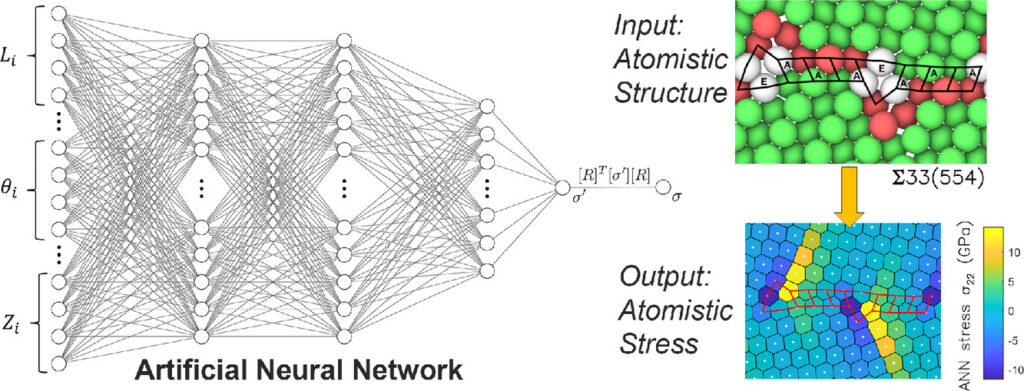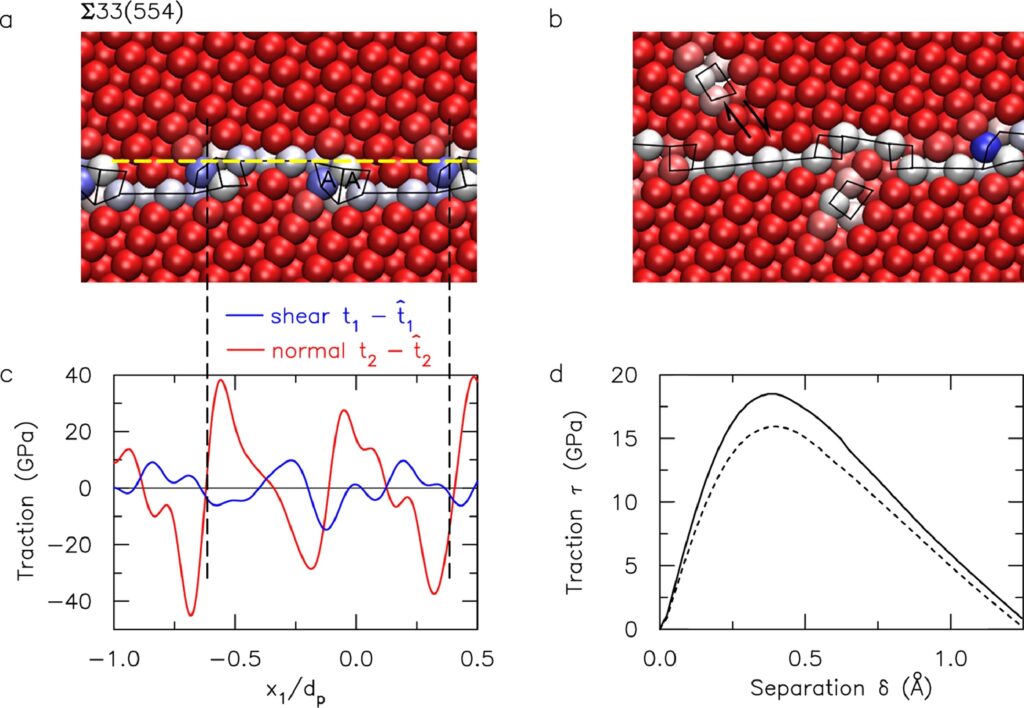Multi-scale Material Modeling and Nanomechanics
Understanding the mechanics behavior of material is essential when designing structural components especially in spacecraft and aircraft where the margin of errors is relatively small. In the late 1700s up, countless efforts have been made to develop constitution governing equations for the mechanics at micro and macro scale. These efforts set the foundation for classical continuum mechanics. In the late 1900s, chemists and physicists help develop quantum mechanics, dealing with atomic interaction and atomic structure. The atomic scale, (5nm to 10 micrometers), however, contains a lot of unknown and is not yet well understood.
There are various problems in the mechanics at this atomic scale. Here we focus on the mechanics of grain boundaries interaction within the solid because the presence of these boundaries can vastly alter the micro and macro scale properties. Especially, we seek to understand the notion of stress at these grain boundaries. These grain boundary stresses are responsible for the fracture and fatigue properties of the metal, but until now, such detailed atomic-scale stress measurements were confined to molecular dynamics simulation models. Using data-driven approaches based on machine learning enables the study to quantify, for the first time, the grain boundary stresses in actual metal specimens imaged by electron microscopy.
For instance, we used molecular dynamics simulations of copper grain boundaries to train our machine learning algorithm to recognize the arrangements of the atoms along the boundaries and identify patterns in the stress distributions within different grain boundary structures. Eventually, the algorithm was able to predict very accurately the grain boundary stresses from both simulation and experimental image data with atomic-level resolution. With this stress, we are able to upscale the traction and understand dislocation emission behavior.
Being able to establish quantitative descriptors of the boundaries will enable scientists to engineer grain boundaries to be stronger, and more heat and corrosion resistant – the first step towards designing aerospace materials for extreme environment applications.
CURRENT WORK:
Currently, we are working on finding dislocation structures using central neural network (CNN) in addition to representing the grain boundary structures using a genetic algorithm. All these current works are based on the atomistic stress field in our previous work.
MOST RECENT WORK:

We introduce a numerical technique, termed the sequential atom removal (SAR) approach, to reconstruct the atomic stresses near a symmetrical-tilt Σ5(310)[001] Cu grain boundary. In the SAR approach, individual atoms near the boundary are sequentially removed to compute the pair (reaction) force between atoms, while correcting for changes to the local electron density caused by atom removal. We show that this SAR approach accurately reproduces the spatially-varying virial stresses at a grain boundary governed by an embedded atom method potential. The SAR approach is subsequently used to extract the atomistic stresses of the grain boundary from DFT calculations, from which we reconstruct a continuum-equivalent grain boundary traction distribution as a quantitative descriptor of the grain boundary atomic structure.

We use artificial neural networks for machine learning (ML), fed with a limited training dataset from MD simulations, to predict the local atomistic stresses from atomic position information across a series of equilibrium <110> symmetrical-tilt Cu grain boundary structures. This ML-based constitutive modeling paves the way for direct interpretation of the equivalent stress state of atomistic structures beyond the MD domain, including those from high-resolution transmission electron microscopy (HRTEM) imaging and Density Functional Theory (DFT).

We reconstruct the continuum-equivalent grain boundary tractions from local atomic stresses near symmetrical-tilt〈110〉 Ni grain boundaries. We show that the resolved shear stress contribution from the grain boundary tractions, τGB, along active slip-systems either assists or prevents the emission of dislocations, depending on its direction with respect to the resolved shear stress contribution from external loading, τext. Our results quantitatively explain the asymmetrical grain boundary dislocation emission processes observed in molecular dynamics (MD) simulations under applied tensile and compressive loads.
